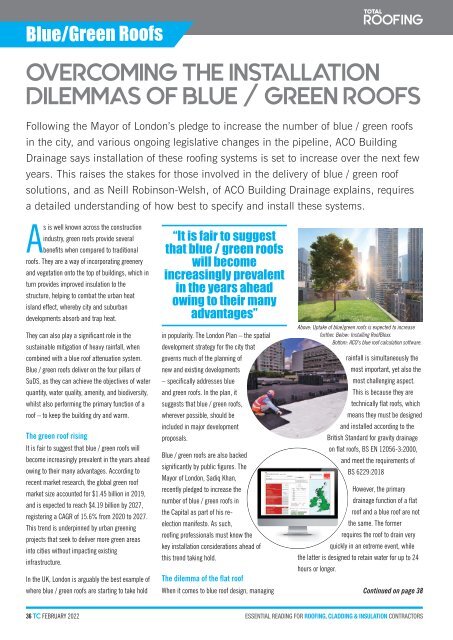February 2022
Create successful ePaper yourself
Turn your PDF publications into a flip-book with our unique Google optimized e-Paper software.
Blue/Green Roofs<br />
OVERCOMING THE INSTALLATION<br />
DILEMMAS OF BLUE / GREEN ROOFS<br />
Following the Mayor of London’s pledge to increase the number of blue / green roofs<br />
in the city, and various ongoing legislative changes in the pipeline, ACO Building<br />
Drainage says installation of these roofing systems is set to increase over the next few<br />
years. This raises the stakes for those involved in the delivery of blue / green roof<br />
solutions, and as Neill Robinson-Welsh, of ACO Building Drainage explains, requires<br />
a detailed understanding of how best to specify and install these systems.<br />
As is well known across the construction<br />
industry, green roofs provide several<br />
benefits when compared to traditional<br />
roofs. They are a way of incorporating greenery<br />
and vegetation onto the top of buildings, which in<br />
turn provides improved insulation to the<br />
structure, helping to combat the urban heat<br />
island effect, whereby city and suburban<br />
developments absorb and trap heat.<br />
They can also play a significant role in the<br />
sustainable mitigation of heavy rainfall, when<br />
combined with a blue roof attenuation system.<br />
Blue / green roofs deliver on the four pillars of<br />
SuDS, as they can achieve the objectives of water<br />
quantity, water quality, amenity, and biodiversity,<br />
whilst also performing the primary function of a<br />
roof – to keep the building dry and warm.<br />
The green roof rising<br />
It is fair to suggest that blue / green roofs will<br />
become increasingly prevalent in the years ahead<br />
owing to their many advantages. According to<br />
recent market research, the global green roof<br />
market size accounted for $1.45 billion in 2019,<br />
and is expected to reach $4.19 billion by 2027,<br />
registering a CAGR of 15.6% from 2020 to 2027.<br />
This trend is underpinned by urban greening<br />
projects that seek to deliver more green areas<br />
into cities without impacting existing<br />
infrastructure.<br />
In the UK, London is arguably the best example of<br />
where blue / green roofs are starting to take hold<br />
“It is fair to suggest<br />
that blue / green roofs<br />
will become<br />
increasingly prevalent<br />
in the years ahead<br />
owing to their many<br />
advantages”<br />
in popularity. The London Plan – the spatial<br />
development strategy for the city that<br />
governs much of the planning of<br />
new and existing developments<br />
– specifically addresses blue<br />
and green roofs. In the plan, it<br />
suggests that blue / green roofs,<br />
wherever possible, should be<br />
included in major development<br />
proposals.<br />
Blue / green roofs are also backed<br />
significantly by public figures. The<br />
Mayor of London, Sadiq Khan,<br />
recently pledged to increase the<br />
number of blue / green roofs in<br />
the Capital as part of his reelection<br />
manifesto. As such,<br />
roofing professionals must know the<br />
key installation considerations ahead of<br />
this trend taking hold.<br />
The dilemma of the flat roof<br />
When it comes to blue roof design, managing<br />
Above: Uptake of blue/green roofs is expected to increase<br />
further. Below: Installing RoofBloxx.<br />
Bottom: ACO’s blue roof calculation software.<br />
rainfall is simultaneously the<br />
most important, yet also the<br />
most challenging aspect.<br />
This is because they are<br />
technically flat roofs, which<br />
means they must be designed<br />
and installed according to the<br />
British Standard for gravity drainage<br />
on flat roofs, BS EN 12056-3:2000,<br />
and meet the requirements of<br />
BS 6229:2018<br />
However, the primary<br />
drainage function of a flat<br />
roof and a blue roof are not<br />
the same. The former<br />
requires the roof to drain very<br />
quickly in an extreme event, while<br />
the latter is designed to retain water for up to 24<br />
hours or longer.<br />
Continued on page 38<br />
36 TC FEBRUARY <strong>2022</strong>

















